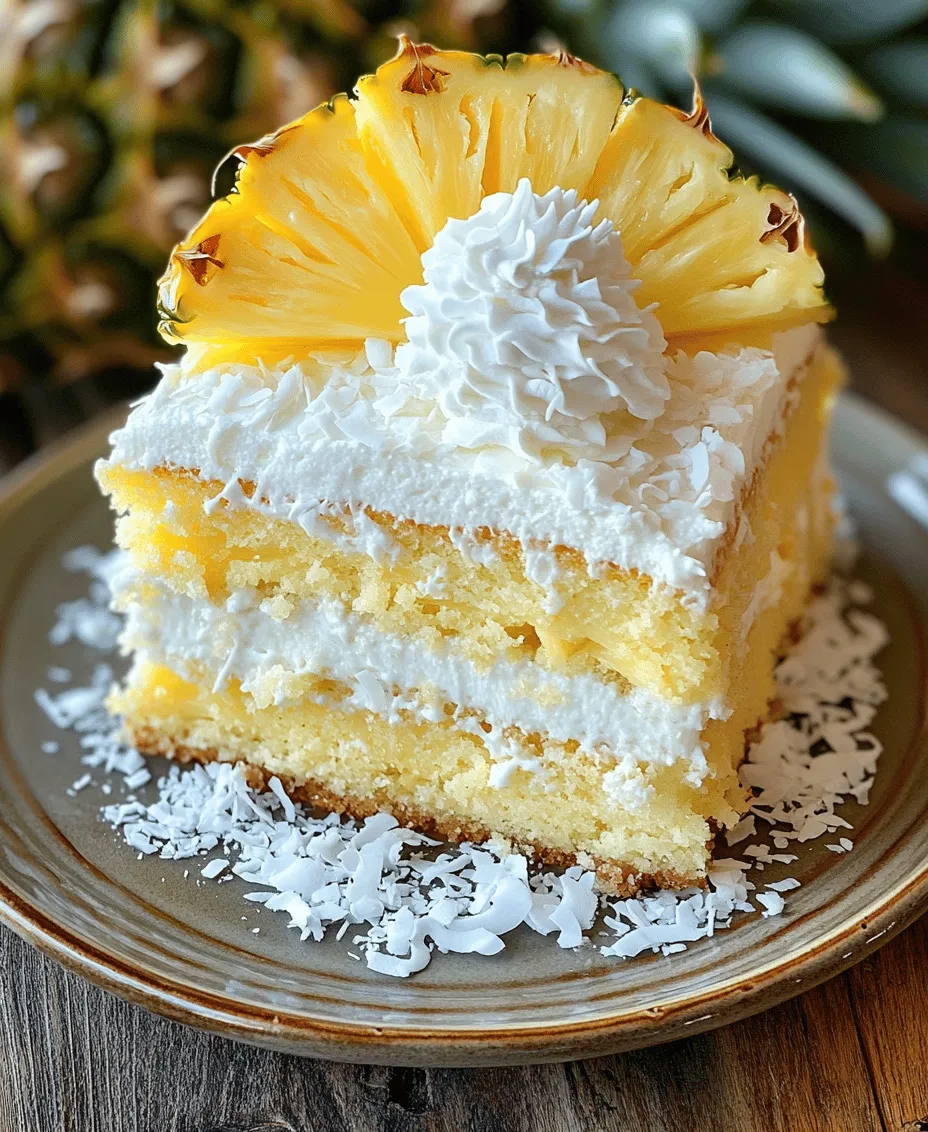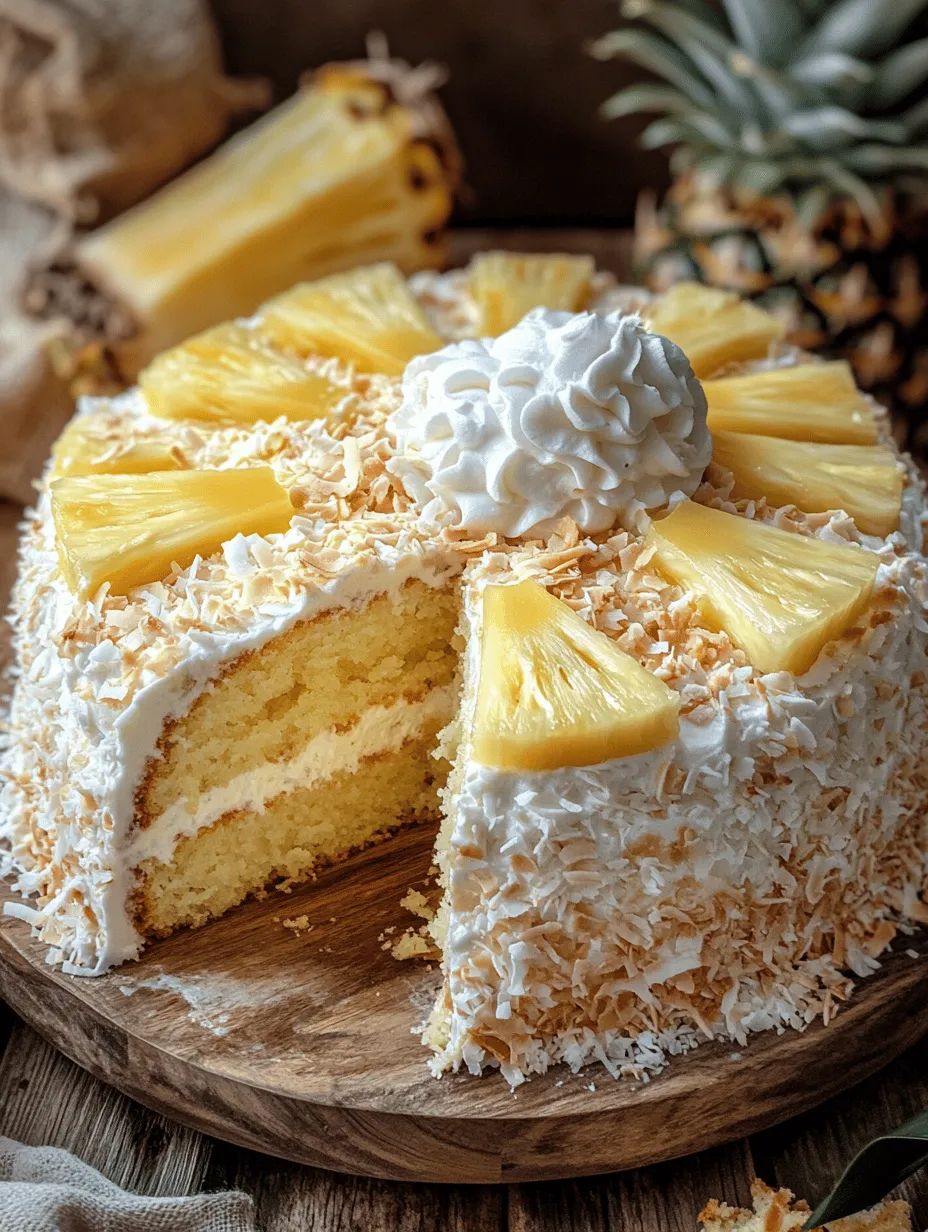Introduction to Tropical Bliss Pineapple Cake
The Tropical Bliss Pineapple Cake is a delightful dessert that brings a taste of the tropics straight to your kitchen. This cake captures the essence of sun-drenched beaches and swaying palm trees, making it the perfect addition to any occasion. Imagine a moist, fluffy cake infused with the sweet and tangy flavor of ripe pineapple, complemented by the creamy richness of coconut. Whether you’re hosting a summer barbecue, celebrating a birthday, or simply indulging a sweet craving, this cake is sure to impress your guests and satisfy your taste buds.
Originating from the lush landscapes of tropical regions, pineapple cakes have become a popular dessert in many cultures, celebrated for their vibrant flavors and moist textures. The Tropical Bliss Pineapple Cake takes this beloved classic and elevates it with the addition of coconut, creating a harmonious blend of flavors that is both refreshing and comforting. The recipe is not just delicious; it is also simple enough for bakers of all skill levels to tackle, making it a great choice for both novice and experienced home cooks.
In this article, we will delve into the essential ingredients that make up this delightful cake, provide detailed step-by-step instructions for baking it to perfection, and share some tips for ensuring the best results. By the end of this guide, you’ll have all the knowledge and confidence you need to create a Tropical Bliss Pineapple Cake that will be the highlight of your next gathering.
Understanding the Ingredients
Before we dive into the baking process, let’s take a closer look at the key ingredients that contribute to the deliciousness of the Tropical Bliss Pineapple Cake. Each component plays a vital role in achieving the right texture and flavor, so understanding their functions will help you appreciate the recipe even more.
All-Purpose Flour: The Foundation of the Cake
All-purpose flour is the backbone of many baked goods, including cakes. It provides the necessary structure and stability, allowing the cake to rise and hold its shape. When using all-purpose flour, it’s important to measure it correctly to avoid a dense cake. For those with gluten sensitivities, gluten-free alternatives such as almond flour, coconut flour, or a store-bought gluten-free flour blend can be used. While the texture may vary slightly, the overall flavor of the cake can still be delightful.
Sugar: Sweetening the Deal
Sugar not only adds sweetness to the cake but also contributes to its texture and moisture content. Granulated sugar is the most commonly used type in cake recipes, but you can also experiment with brown sugar for a deeper flavor or coconut sugar for a more natural option. If you’re looking for healthier substitutes, consider using natural sweeteners like honey, maple syrup, or agave nectar. Keep in mind that these alternatives may affect the moisture level, so adjustments in the liquid ingredients may be necessary.
Unsalted Butter: Creaminess and Flavor
Butter is another key ingredient that adds flavor, moisture, and richness to the cake. Unsalted butter is preferred because it allows you to control the amount of salt in your recipe. For the best results, ensure your butter is at room temperature before starting; this helps create a light and airy texture when creamed with sugar. If you’re looking for a dairy-free option, you can substitute with coconut oil or a plant-based butter alternative.
Eggs: Binding and Moisture
Eggs play a critical role in cake recipes, providing structure, moisture, and richness. They help bind the ingredients together and contribute to the cake’s rise during baking. For those who are vegan or have egg allergies, you can use alternatives such as flaxseed meal mixed with water, applesauce, or commercial egg replacers. Each substitute has its unique characteristics, so you may need to experiment to find the right balance for your cake.
Crushed Pineapple: The Star Ingredient
Crushed pineapple is the star ingredient in this cake, bringing a burst of tropical flavor and natural sweetness. Pineapple is not only delicious but also packed with nutrients, including vitamin C and manganese. When selecting pineapple for your cake, choose fresh or canned options. If using canned pineapple, make sure to drain it well to avoid excess moisture in the batter. For a fresher flavor, you can also chop up fresh pineapple into small pieces.
Coconut Milk: Creamy and Flavorful
Coconut milk adds a rich creaminess to the cake and enhances its tropical flavor. It differs from coconut cream, which is thicker and richer; for this recipe, coconut milk is ideal as it provides the right consistency. If you’re looking for a dairy-free option, coconut milk is a fantastic choice. You can also use alternatives such as almond milk or oat milk, but keep in mind that these may change the flavor profile of the cake slightly.
Baking Powder and Baking Soda: The Leavening Agents
Baking powder and baking soda are essential leavening agents that help the cake rise. Baking powder contains both an acid and a base, making it a complete leavening agent, while baking soda requires an acid (such as vinegar or lemon juice) to activate. Understanding when to use each is crucial; for this cake, both may be required to achieve the perfect texture and height. In most cases, recipes will specify which to use, but it’s good to know the science behind them.
Shredded Coconut: Adding Texture
Shredded coconut adds delightful texture and enhances the tropical flavor of the cake. You can choose between sweetened and unsweetened varieties, depending on your preference and dietary needs. Toasting shredded coconut can elevate its flavor, giving it a nutty aroma that pairs beautifully with the pineapple. If you choose to toast it, simply spread it on a baking sheet and bake at a low temperature until golden brown, stirring occasionally to prevent burning.
Step-by-Step Instructions for Baking Tropical Bliss Pineapple Cake
Now that we have a thorough understanding of the ingredients, it’s time to dive into the step-by-step process of baking your Tropical Bliss Pineapple Cake. With careful attention to detail, you can achieve a cake that’s not only delicious but also visually stunning.
Preheating the Oven and Preparing the Pan
The first step in baking any cake is preheating your oven. This is crucial for ensuring even cooking and the right texture. Set your oven to 350°F (175°C) to get it warmed up while you prepare the batter.
Next, you’ll want to prepare your cake pan. For this recipe, a standard 9-inch round cake pan works perfectly. Grease the pan generously with unsalted butter or cooking spray to prevent sticking. To ensure an easy release, you can also line the bottom of the pan with parchment paper. This step is particularly important for moist cakes like the Tropical Bliss Pineapple Cake, as they can sometimes stick to the pan.
Creaming Butter and Sugar for a Light Texture
Once your oven is preheated and your pan is prepared, it’s time to start making the batter. Begin by placing the room-temperature unsalted butter and granulated sugar in a mixing bowl. Using an electric mixer, cream the butter and sugar together on medium speed until the mixture is light and fluffy. This process typically takes about 3-5 minutes and is essential for incorporating air into the batter, which will help create a light texture in your cake.
After achieving the desired consistency, add in your eggs one at a time, mixing well after each addition. Be sure to scrape down the sides of the bowl as needed to ensure everything is well combined. Following this, pour in the coconut milk and mix until fully incorporated. This addition will enhance both the moisture and flavor of your cake, making it irresistibly delicious.
As you continue mixing, gradually add the dry ingredients—sifted all-purpose flour, baking powder, baking soda, and a pinch of salt. Mix until just combined; overmixing can lead to a dense cake, so be careful not to overdo it. Lastly, gently fold in the crushed pineapple and shredded coconut until evenly distributed throughout the batter.
Now that your batter is ready, you are just a few steps away from creating your Tropical Bliss Pineapple Cake. Stay tuned for the next part of this guide, where we will cover the final steps of baking and additional tips to ensure your cake comes out perfectly every time.

Techniques for Achieving the Perfect Creaming Consistency
Creaming butter and sugar is a crucial step in baking, especially for achieving a light and airy texture in your Tropical Bliss Pineapple Cake. To ensure you reach the perfect creaming consistency, start with softened butter, ideally at room temperature. This allows the butter to trap air effectively as you mix it with sugar. Use an electric mixer on medium speed for 3-5 minutes until the mixture becomes light and fluffy. The color should change to a pale yellow, indicating that enough air has been incorporated.
Common Mistakes to Avoid During This Step:
1. Using Cold Butter: Cold butter is difficult to cream and will result in a dense cake. Always let your butter soften before starting the creaming process.
2. Not Mixing Long Enough: Rushing through this step can lead to a heavy cake. Take your time to ensure a light and airy mixture.
3. Incorrect Sugar Type: Use granulated sugar for the best results. Brown sugar can produce a denser cake and alter the expected texture.
Incorporating Eggs and Flavorings
Adding eggs to your batter is not just about binding the ingredients. It plays a significant role in the structure and moisture of the cake. When incorporating eggs, do so one at a time. This method allows each egg to fully incorporate before adding the next, ensuring an even distribution of moisture and fats throughout the mixture.
How Flavorings Enhance the Overall Taste of the Cake:
Flavorings such as vanilla extract or almond extract are crucial for rounding out the taste of your Tropical Bliss Pineapple Cake. A teaspoon of pure vanilla extract will elevate the cake’s flavor profile, complementing the pineapple and coconut beautifully. Consider adding a splash of rum or coconut extract for an extra tropical kick.
Mixing Dry Ingredients: The Key to Even Distribution
Mixing dry ingredients properly is essential for a lump-free batter. Start by whisking the flour, baking powder, and salt together in a separate bowl. This step ensures that the leavening agents are evenly distributed, which is vital for the cake’s rise.
Tips for Ensuring a Lump-Free Batter:
– Sift Your Dry Ingredients: Sifting flour, baking powder, and salt before combining them helps break up clumps and aerates the flour, resulting in a lighter cake.
– Gradually Add Dry Ingredients: When incorporating the dry mixture into the wet ingredients, add it gradually. This helps avoid lumps and ensures even mixing.
Folding in Pineapple and Coconut
Once your batter is ready, it’s time to fold in the star ingredients: pineapple and coconut. Folding is a gentle mixing technique that preserves the aeration created during the previous steps.
The Technique of Folding Versus Stirring:
To fold, use a spatula to lift and turn the batter from the bottom of the bowl, gently incorporating the pineapple and coconut without deflating the batter. This step is crucial as it retains the lightness of the cake while ensuring that all ingredients are uniformly mixed.
Ensuring Even Distribution Without Overmixing:
Fold until you see no dry flour, but be cautious not to overmix. Overmixing can lead to a dense cake, as it develops the gluten in the flour, counteracting the tender texture you desire.
Baking the Cake to Perfection
Baking time can vary based on your oven, but there are signs to look for to ensure your cake is perfectly baked. Generally, your Tropical Bliss Pineapple Cake will take around 25-30 minutes at 350°F (175°C).
Signs That Your Cake Is Done Baking:
– The edges should start to pull away from the sides of the pan.
– The top will be golden brown and spring back when lightly pressed.
How to Test for Doneness with a Toothpick:
Insert a toothpick into the center of the cake; if it comes out clean or with a few moist crumbs, your cake is ready. If it has wet batter on it, return the cake to the oven for a few more minutes and test again.
Cooling the Cake: Importance of Patience
Cooling your cake properly is essential for retaining its structure and ensuring it slices well. Allow the cake to cool in the pan for about 10-15 minutes before transferring it to a wire rack.
Why Cooling in the Pan Is Essential:
Cooling in the pan helps set the cake, reducing the risk of it falling apart during transfer. The residual heat will also continue cooking the cake slightly, ensuring a perfectly baked interior.
Tips for Transferring the Cake Without Damaging It:
– Use a thin, flexible spatula to gently lift the edges of the cake from the pan.
– If using a round cake pan, place the wire rack on top and invert the pan to let the cake slide onto the rack.
– Allow the cake to cool completely before frosting or serving, as this will prevent the frosting from melting.
Garnishing and Serving Your Tropical Bliss Pineapple Cake
Garnishing your cake not only enhances its visual appeal but also adds to the overall flavor experience. Here are some creative ideas to elevate your Tropical Bliss Pineapple Cake.
Creative Garnishing Ideas
– Using Fresh Pineapple Slices: Top your cake with fresh pineapple slices for a vibrant and tropical touch. You can also grill the slices to caramelize them slightly before placing them on the cake.
– Suggestions for Pairing with Whipped Cream or Coconut Whipped Cream: A dollop of whipped cream or coconut whipped cream on each slice adds a rich, creamy element that complements the fruity flavors beautifully. Consider garnishing with toasted coconut flakes for added texture and flavor.
Serving Suggestions and Pairings
To create a complete tropical experience, consider the following serving suggestions:
– Ideal Beverages to Accompany the Cake: Light beverages such as iced tea, coconut water, or a fruity cocktail like a piña colada pair excellently with the cake, enhancing its tropical theme.
– Other Tropical-Themed Desserts to Complement Your Meal: Serve the cake alongside coconut macaroons or a mango sorbet for a delightful dessert spread that will impress your guests.
Nutritional Information and Benefits of Tropical Ingredients
Understanding the nutritional value of the ingredients in your Tropical Bliss Pineapple Cake can enhance your appreciation for this delightful dessert.
Health Benefits of Pineapple
Pineapple is not just delicious; it is also packed with nutrients. It is rich in vitamins C and B6, manganese, and antioxidants. Pineapple contains bromelain, an enzyme that aids in digestion, making it a great addition to your diet.
Coconut and Its Nutritional Value
Coconut is another tropical powerhouse. Coconut milk is a source of healthy fats, while shredded coconut provides fiber and minerals. Incorporating coconut into your diet can contribute to heart health and provide energy, making it a nutritious addition to your baking.
Conclusion: A Slice of Paradise Awaits
The Tropical Bliss Pineapple Cake is not just a dessert; it’s an experience that transports you to a sunny paradise with every bite. With simple ingredients and straightforward instructions, this cake is accessible for bakers of all skill levels. The unique combination of pineapple and coconut creates a delightful flavor profile that will leave your guests enchanted.
Whether enjoyed solo or shared with friends and family, this cake is a wonderful addition to any gathering, making it a must-try recipe for anyone looking to add a touch of tropical bliss to their culinary repertoire. So gather your ingredients, follow the steps, and prepare to indulge in a slice of paradise that will keep you coming back for more.


